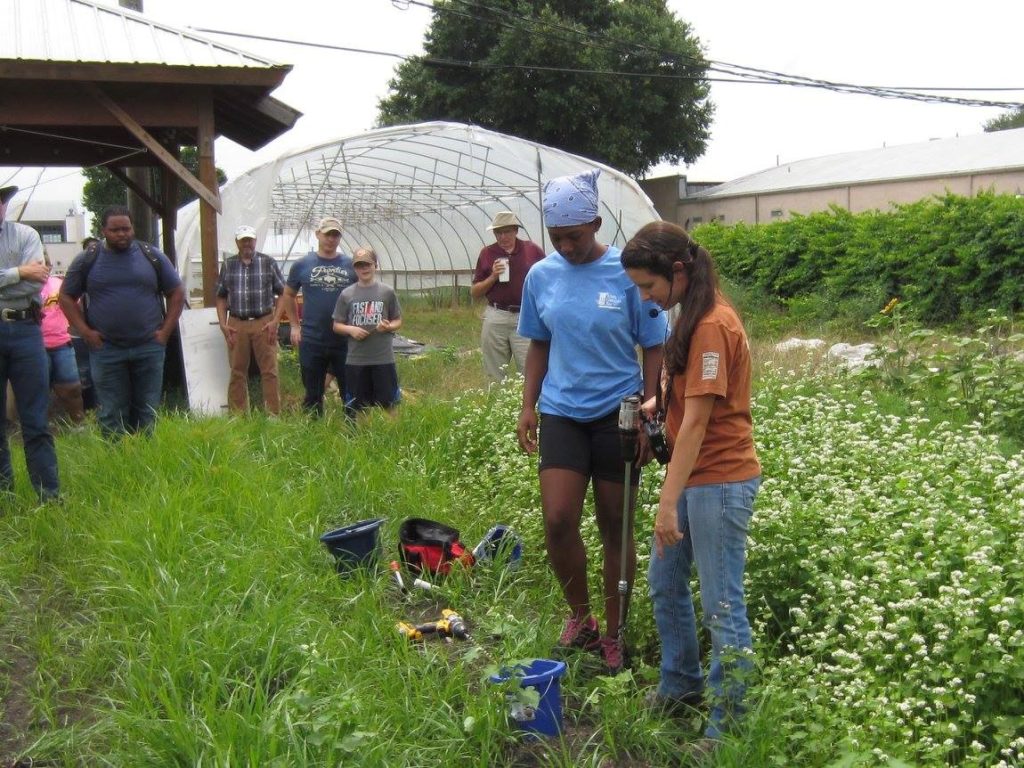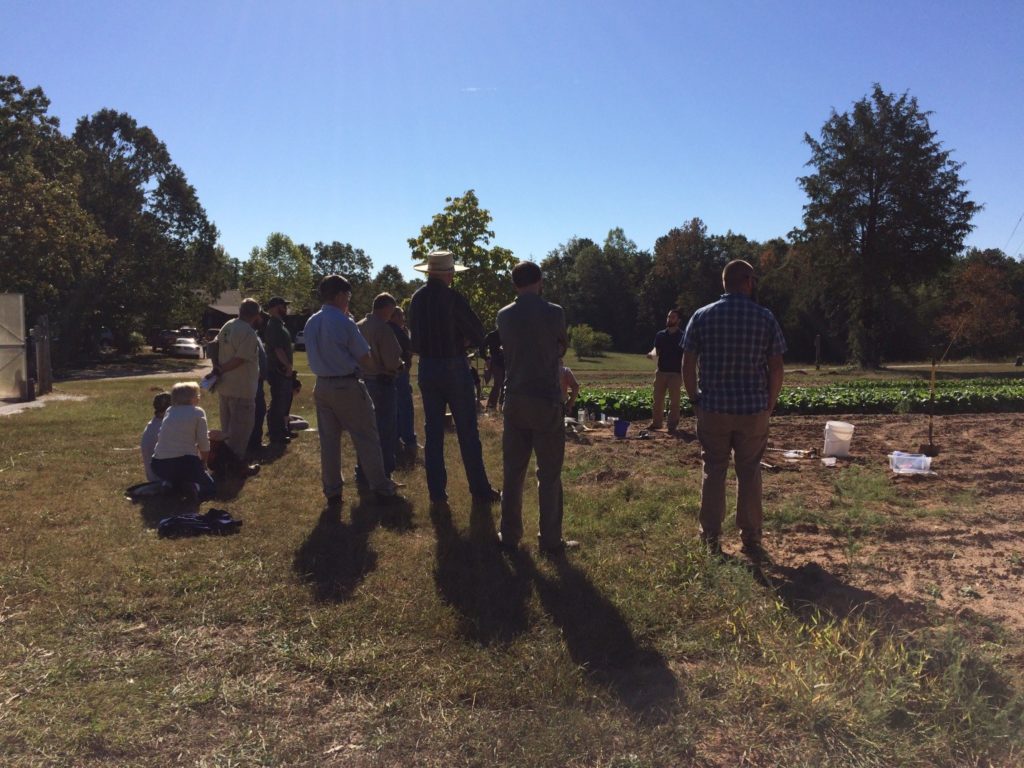By Gena Moore, CFSA Organic Research Coordinator & Mark Dempsey, CFSA Farm Services Coordinator.
Soil is the building block for much of life. Many farmers strive to increase and maintain their soil health in order to produce vibrant, nutrient-dense crops and livestock products.
Healthy soil generally has higher nutrient availability for plant-uptake, resists erosion and compaction, retains more water, and imparts resilience to crops in the face of pressure from diseases, insect pests, and weeds.
There are a variety of conservation practices that are strongly recommended to foster soil health, including cover cropping, reducing tillage, adding organic matter, as well as using diverse crop rotations, which may include the integration of livestock. Growers can monitor progress toward soil health goals in a variety of ways:
- Visually assess soil structure (aggregation) and look for signs of life (roots, earthworms, insects, decomposing organic matter, and so on). Well-structured soil should have a lot of pore space and should appear to be made up of crumbs.
- Assess crop health. Nutrient deficiencies are evident in crop appearance and yields, as well as susceptibility to pest pressure.
- Test the soil for its chemical, physical and biological properties.
While we’re talking about soil tests, let’s take a closer look.
Standard soil tests measure many things, such as the levels of 5-10 nutrients, soil pH, Cation Exchange Capacity (CEC), provide valuable information about plant-available nutrients, and can indicate fertilizer rates needed to achieve good crop yields.
Standard soil test methods do not typically provide additional information about the soil’s health—such as aggregate stability, organic matter (optional on standard tests), active carbon, or biological activity, which is a proxy for many soil health properties.
Those interested in using less fertilizer, and therefore saving money, may find a testing method that measures biological activity – to estimate nutrients that will become plant-available over the course of the growing season – of particular interest. This is because nutrients that make up organic matter are not plant-available, and are made available to plants via the decomposition of organic matter by soil microorganisms. Thus, accounting for nutrient release from organic matter (estimated by measuring biological activity) can better reflect the total amount of plant-available nutrients in soil during the growing season, compared to standard soil testing methods, which only measure plant-available nutrients.
Currently, there are alternative tests for farmers that provide information about soil health and nutrient release from organic matter. It’s a high priority for growers and agricultural professionals interested in using alternative soil tests to understand how these options offer different insights for soil health and management.
Soil Health Field Day held at City Roots Farm. Photo Credit: Richland County Soil and Water Conservation District
In 2015, CFSA entered into an agreement with the South Carolina Natural Resources Conservation Service (SC NRCS) to compare standard soil testing to an alternative soil test. We looked at testing provided by Clemson University’s Agriculture Service Laboratory and the Haney Soil Nutrient Tool (HSNT), provided by the Grassland Soil and Water Research Laboratory in Temple, Texas.
To do this, we worked with three South Carolina certified organic farms to participate in a three-year demonstration:
- Bioway Farm (Laurens County)
- City Roots Farm (Richland County)
- Three Sisters Farm (Beaufort County)
At each farm, two adjacent plots were set-up: one with soil tested by Clemson Ag Service Lab, and one with soil tested by the HSNT – both tested multiple times during the three-year period. Adjacent plots were managed independently, using different fertilizer types and amounts or cover crops based on recommendations from either testing service. Crop yields were also collected separately for adjacent plots.
The results of this study identified some important differences between standard soil testing methods and the HSNT. In general, recommended fertilizer amounts from the HSNT were consistently less than those from Clemson’s soil test, owing to the fact that HSNT accounts for nutrients released from organic matter over the course of the season. Further, because yields were similar between the two test plots, the reduced fertilizer amounts in HSNT plots led to small cost savings for farmers.
Other differences in the two soil tests included:
- Micronutrients: Clemson’s test provides more complete information on soil micronutrients.
- Cost: Clemson’s test costs $6 per sample. HSNT typically costs about $50 per sample.
- Cover Crops: HSNT provides cover crop recommendations to increase soil health.
- Score: HSNT provides a “soil health score” based on the tested aspects of the soil. This can be used as a single metric to track progress over time.
- Cost Savings: HSNT provides more information on microbial activity and estimated nutrient release in the soil, which informs fertilizer recommendations and may lead to cost savings.
- Consistency: HSNT results, particularly those based on biological activity, were highly variable over the course of the year. Clemson’s results, which are not based on biological activity, were more consistent throughout the year. If using HSNT, any cost savings from reducing fertilizer use may depend on the time of year your sample is taken. Further research is needed to better understand seasonal variability and its effects on fertilizer recommendations.
Soil Health Field Day held at Bioway Farm.
Finally, as a part of the demonstration, field days were held across South Carolina at the participating farms along with several other local farms. Over two hundred framers and agriculture professionals were trained on proper soil sample techniques, new technology in soil sampling, practices to promote soil health, and understanding fertilizer recommendations based on soil test results.
Demonstrations are important because what we know about soil health and how to measure it continues to evolve. We should expect new soil tests, like HSNT, to continue to become commercially available. It’s critical that we understand what the new and old soil testing methods have in common, and what makes the newer tests useful for identifying and monitoring soil health goals over time.
Our take away:
- Decide if measuring soil health is a priority for you.
- If it is, then how would you like to measure it (e.g. soil testing, visual assessment, crop condition)?
- Pick a soil testing lab and stick with it. It’s important to keep soil testing methodology the same over time if you want to monitor progress.
- Aim to sample your soil at the same time of year each year, and under similar environmental conditions, if possible. This can help avoid inconsistencies that might arise from seasonal changes in biological activity or nutrient release.
Regardless of the lab and methodology you choose, if monitoring soil health is a priority for you, be sure to have your soil tested at least once per year and track of changes over time – hopefully, you’ll eventually see the improvements in soil nutrients and health that you want to see.
Want to learn more?
Consulting
For one-on-one help on how to implement these soil health and other conservation practices on your farm, see our Conservation Planning Service.
CFSA writes a specific conservation plan that is tailored to farms that are organic and transitioning to organic. For more information visit our webpage, and then contact your local NRCS office.





